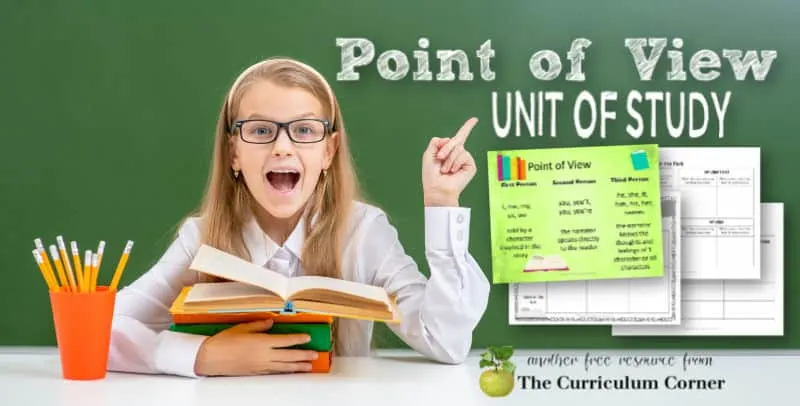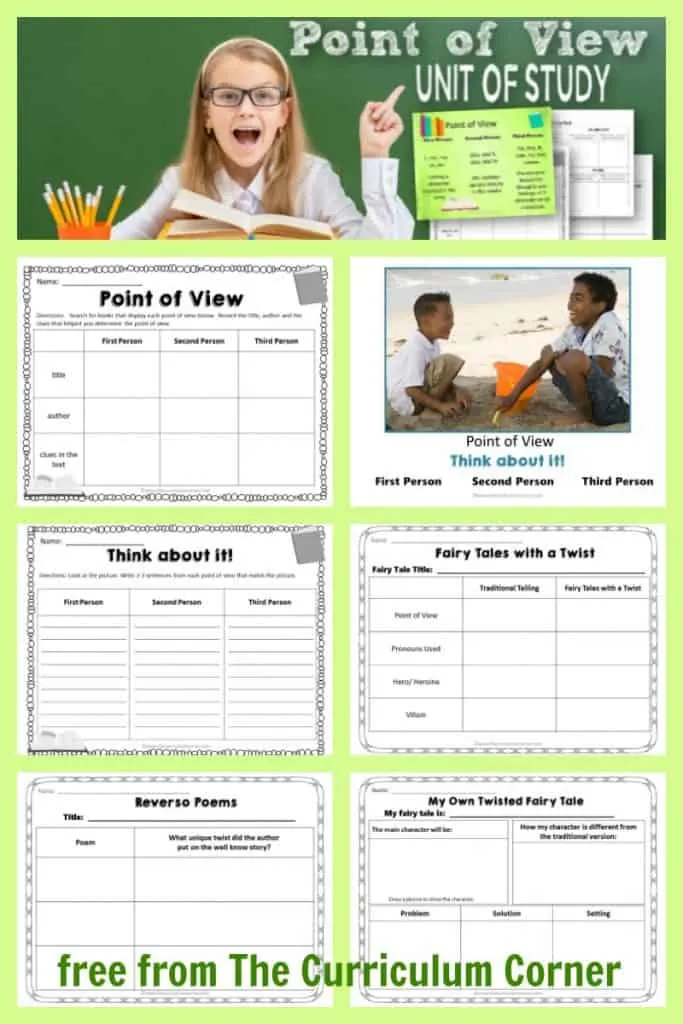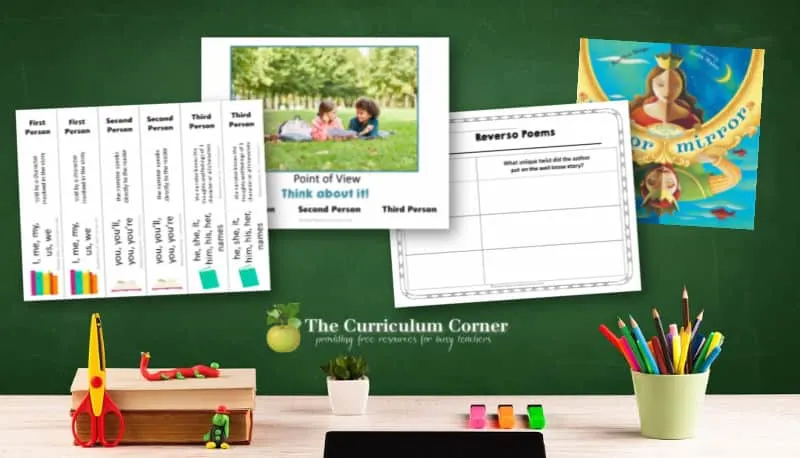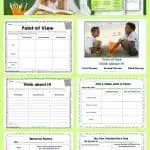Use this unit of study to give your students practice determining point of view in reading.

This is another free resource for teachers from The Curriculum Corner.
You can find the entire collection of point of view resources described below in a single download at the bottom of this post.
Thank you to Jennifer Nealy for helping in the creation of this mini-unit. Her ideas and lessons were used to create some of the ideas you see below.
These lessons will address this standard:
Compare and contrast the point of view from which different stories are narrated.
Point of View Introduction
Start with an optical illusion to introduce the concept.
You can download one to use here:
Optical Illusion PowerPoint (PDF version)
Display the PowerPoint on your smartboard. Begin with the duck/rabbit picture.
Class discussion: Ask students what they see.
- Talk about the difference of opinion. Who is correct? Is there one correct answer?
- Can your point of view change? Why/why not?
- Depending on your point of view you may see something different than your classmates or you may see the same thing.
- How would you define “point of view”? The position from which something or someone is observed. In a story, it is the way a story is told by the narrator.

Point of View in Literature
We like using Flocabulary’s video to help students develop an understanding of the concept in terms of literature. This clip contains first, second and third person.
Ask students: What did you learn from the video?
Anchor Chart
Use our anchor chart to help students develop an understanding of first, second and third person views.
You may choose to display the one included or use it as a reference and have your students create their own with your guidance.
Once students understand the differing points of view, have them complete the Point of View graphic organizer.
Students will work independently or in small groups (you choose) to find examples of each point of view in the classroom library.
Along with sharing the title and author, they should include the clue words that helped them identify their answers.
You will also find a smaller version of this form students can use in interactive notebooks or as an exit ticket.
Bookmarks
You will find six bookmarks on a page. Print on card stock and laminate. Cut apart the bookmarks and they are ready to use.
Students can work at a literacy center or in groups to go on a point of view search.
Their goal is to find a book that is written from each point of view. Students will place the bookmark in a spot that offers evidence to support their thinking.
If needed, encourage students to refer to the anchor chart that contains common pronouns.
Think About It!
A set of four photos are a part of this activity.
The photos can be displayed on your interactive board or you can choose to print.
Work as a whole class, in small groups or individually depending on your students.
Your children will write a few sentences from each point of view that match the photo.
You will find a graphic organizer to use but you can also choose to have students write in their reading notebook or on a class anchor chart.
Voices in the Park
- First read: Have your students read the text Voices in the Park by Anthony Browne. Have the students discuss what they noticed about the different points of view throughout the text. How were they the same? How were they different?
- Second read: Hand out an organizer titled Voice in the Park for students to note the point of view from each character in the text. Explain to the students that they will complete the organizer as you reread the text to them. They should be looking for how each character thinks and feels about the other characters in the text and what we learn about the character themselves.
- Sharing: After the students have completed the organizer, have them have a small group discussion about their findings and then have a whole group discussion.
- Class Discussion:
- Was each chapter told in first or third person? How do you know?
- What did you notice about the way the characters thought about each other?
- Did any of the characters have a similar point of view to another character(s)? If so, which ones? What did you notice?
- Did any of the characters have a different point of view to another character(s)? If so, which ones? What did you notice?
- What did we learn about the importance of seeing multiple characters’ point of view?
The Day the Crayons Quit
The Day the Crayons Quit (click through to purchase via Amazon)
- Prereading Activity: Give each group of students a different color crayon and a sheet of paper. Have each student use only that one color to draw a quick picture (3 to 5 minutes) of a person, place or thing. Tell them to keep their eyes on their own papers. Once their drawings are complete, have them share their drawings.
- What similarities did you notice?
- What differences did you notice?
- Why did you choose to draw what you did? Did the color of your crayon affect what you drew?
- Read: The Day the Crayons Quit. As you are reading, have them listen carefully for their color’s point of view. See if they can make any connections to what they drew and what the crayon wrote in the text.
- Class Discussion: Was this text first person or third person? How do you know?
- Writing Activity: Discuss personification (giving human qualities to animals or inanimate objects) with your students. Use the text to model how the crayons have been given human like qualities. With the author using personification we get to see things from the crayons’ points of view. Have a variety of objects for the students to choose from. (stapler, phone, camera, toothbrush, money, tape, flower, ball, etc.) Have your students brainstorm about what life is like for the objects they have chosen. (You will find a graphic organizer that students can use.)
- What do you like?
- What do you dislike?
- Name other objects that are associated with you.
- How do other objects or people see/use you?
- What words or phrases are associated with you?
The students use their brainstorming sheet and their imagination to write a letter to a student, kid, parent, teacher, etc. to voice their concerns about how they (the objects) are being used.

A Favorite Book of Your Choice
**These ideas were originally for Mr. Peadbody’s Apples by Madonna. This book is no longer available on Amazon but if you have a copy of your own, you might choose to use it for these ideas.
- Prereading Activity: Share only the pictures with the class. Have them look closely at the pictures and discuss what they see and what they think is going on in the story. “From our point of view we think…”
- Read Aloud: Read the story to the students. Have students:
- Identify the lesson of the story. They should identify the lesson and use text evidence.
- Identify the point of view. They should identify pronouns to support their answers. (We have included two graphic organizers – one full page and one with four on a page to be used as exit tickets or placed in an interactive notebook.)
- Class Discussion:
- How would the story change if it was written from Mr. Peabody’s point of view?
- Do you think the point of view Madonna chose was the best way to tell the story? Why or why not?
The Other Side of the Story: Fairy Tales with a Twist
This text has five fairy tales with a twist. You can use all of them or pick which ones will work with your class and your lesson.
- Read the traditional story of Cinderella, Little Red Riding Hood, The Three Bears, The Little Mermaid or Jack and the Beanstalk.
- Have the students identify whether the text is told in first or third person. Most traditional fairy tales are told in third person. Have students support their answers by identifying the pronouns in the text. Also have them discuss who the “good guy” and “bad guy” is. You will find a graphic organizer for this activity.
- Read the other version of the fairy tale in The Other Side of the Story. Have the students identify if the story is from the first or third person. Have them support how they know. As in the step above, have them point out the “bad guy” and the “good guy”.
- Now that they have read the two versions of the story have them think about and answer this question:
- How do the different points of views in the two versions of the fairy tale change how we see the characters?
Extension
Writing Activity: Have the students pick a different fairy tale. Have them read the traditional version. From there, have them choose a character from the fairy tale and write the fairy tale from that character’s point of view. You may want to model this process with the students by working together on brainstorming. You will find a graphic organizer for planning.
Reverso Poems
Author Marilyn Singer has written a collection of poetry books which couldn’t be more perfect for your point of view study!
Each book looks at common fairy tales or Greek myths but from a new point of view. The poems are engaging and your students will enjoy them.
Plus, they are a perfect way to give students a little more practice!
Wrapping up the study
Have students complete an end of unit project/activity to show their understanding of point of view (first and third person, how the point of view affects the story…). Some possible projects/activities:
- Have students write a poem, song or comic showing what point of view is, the different types and how point of view affects the story being told.
- Students will create a power point or short video showing what point of view is, the different types and how point of view affects the story being told.
- Have students create a drawing or collage showing what point of view is, the different types and how point of view affects the story being told.
Looking for an extension for older classrooms?
The book Seedfolks by Paul Fleischman is a wonderful addition that will reach your middle school students.
There are themes within this book best for older students. Be sure to read the book before introducing it to your classroom.
You can download these free resources here:
Printable Resources
Here are a few of our favorite books to add to your study. Contains affiliate links.
As with all of our resources, The Curriculum Corner creates these for free classroom use. Our products may not be sold. You may print and copy for your personal classroom use. These are also great for home school families!
You may not modify and resell in any form. Please let us know if you have any questions.
You may not modify and resell in any form. Please let us know if you have any questions.


Preparing Your Reading Workshop - The Curriculum Corner 123
Monday 10th of June 2019
[…] Point of View Mini-Unit for 4th and 5th Grades […]
R
Wednesday 18th of January 2017
This is EXACTLY what I was looking for! ThankYou!
Welcome to the The Curriculum Corner 456 - The Curriculum Corner 4-5-6
Thursday 6th of October 2016
[…] Point of View Mini-Unit […]
Literature Graphic Organizers - The Curriculum Corner 4-5-6
Wednesday 13th of July 2016
[…] Point of View […]